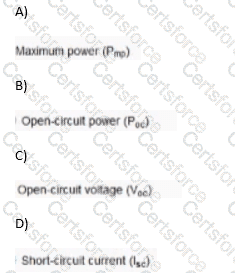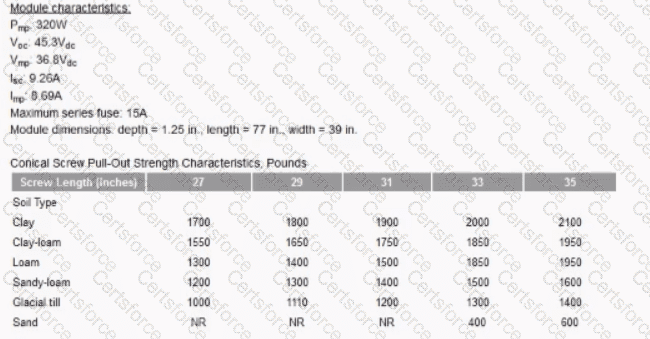An 8 AWG bare copper equipment ground conductor (EGC) is wire tied to the module mounting structure of a commercial rooftop solar array. After a few years of operation, some spots on the EGCbegin to turn a green color and appear to be corroding more significantly that other places. What would the MOST likely cause of the problem?
A PV module has a temperature coefficient of power of -0.4%/°C and a rated power of 300W at STC (25°C). What is the expected power output if the module temperature rises to 55°C?
A string inverter fails to start in the morning. The DC input voltage is 200V, below the minimum start voltage of 250V. What should be checked first?
The AHJ for enforcement of the NEC has which responsibility?
A residential PV system uses two 120.240Vac utility-interactive inverters with a sealed lead-acid battery energy backup for protected loads. The MOST important protected load consideration when operating in the backup mode is that:
A site survey indicates a residential roof with a 4:12 pitch facing 20° east of south. The local latitude is 35°N, and the optimal tilt for maximum annual production is equal to latitude. What adjustment should be made to compensate for the roof’s orientation and tilt to achieve near-optimal output?
A 7KW/ 14 KWh multimode system has been installed at a residence, ac-couple with the customer’s existing 6.7kwh ac PV system. The system providers uninterrupted power to a protect loads subpanel, which is connected to a refrigerator,
Microwave, 1.0 ton are conditioner, three lightning circuit, and the 6.7kwac PV system. One month later, the homeowner moves additional circuits to the protected loads subpanel, substantially increasing the loads. Why would this cause, the backfed interconnection breaker in the main service panel to trip?
Which temperature coefficient is used in the calculation to verify energy production of a PV system?

An installer has decided to use 31 in. long. 3.1/2 in diameter conical ground screws as the footings for a 3.840W solar electric system. Access to he is too difficult to pour concrete footings. The soll is classified as sandy loam. The design wind speed is 90 mph with an uplift force of 32 ibs/ft2. What is the MINIMUM number of screw required to resist uplift loads?

A 10 kW array produces 14,000 kWh annually. What is the specific yield in kWh/kW?